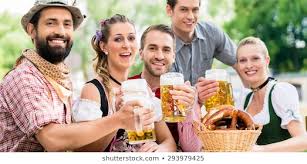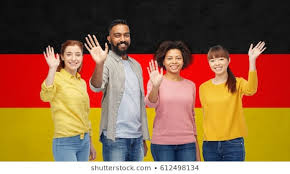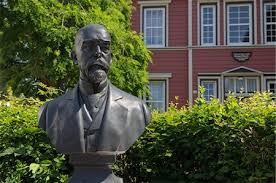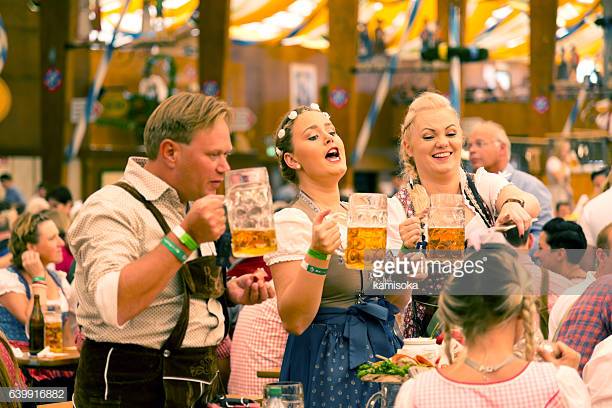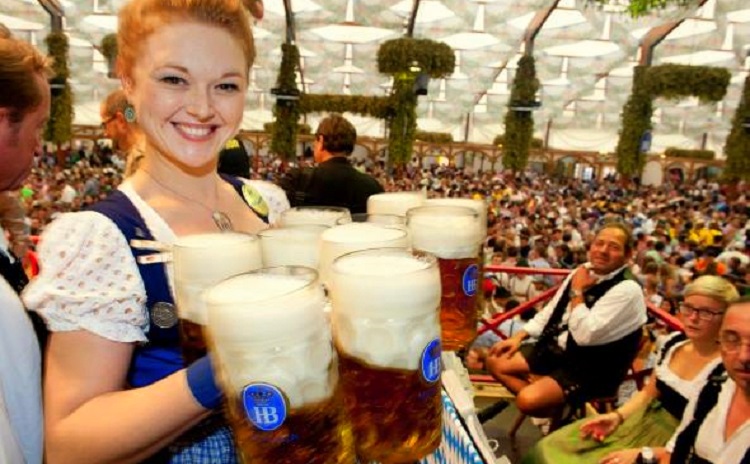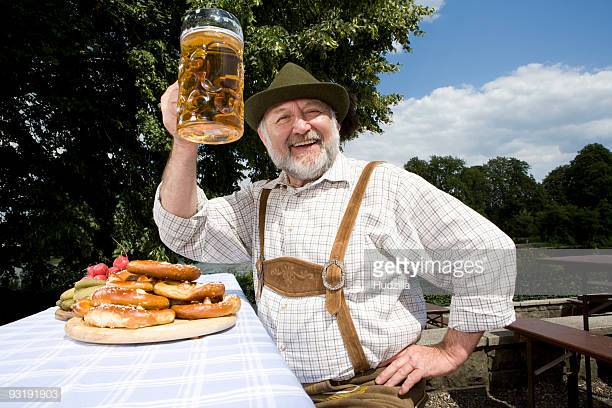Music
Germany Celebrates a vast amount of musical genres, and was/is the birth place of many
composers, singers, producers and performers of the world.
For a more in-depth list of Music in Germany click here.
Art
German art has a long and distinguished tradition in the visual arts, from the earliest known work of
figurative art to its current output of contemporary art.
More information here.
Dance
Zwiefacher
This dance is for the most part famous in Bavaria. The translation oddly enough has nothing to do with the dance itself. Zwiefacher means twice or double the times. You might want to assume it has something to do with the melody or the rhythm of the dance, but actually it doesn’t at all considering the dance alternates between a 3/4 and 2/4 meter. Some speculate that the name has something to do with the fact that the dance is between two dancers dancing closely together, which was a rare affair at the time.
Expressionist Dance
Expressionist dance became most famous in Germany during the Weimar period. Mary Wigman was the leading pioneer of this movement along with Rudolf von Laban. They understood dance as a metaphysical experience. Wigman was a student of Laban, and she transformed his ideas into an existential human experience. She most famously performed “Dance of the Witches,” and the “Dance of Death,” which are some of the most well-known dances from this time. Wigman toured in the USA and marked Expressionist dance as a German dance, which influenced modern dance in the US. However, due to the fact that this movement was linked to Germany, by the late ’30s, the movement and its dancers were forced into exile and became illegal and seen as anti-nationalistic.
Schuhplattler
If you’ve ever seen a dance where male dancers in a line or circle are repeatedly hitting the soles of their shoes, their thighs, and their knees, this is Schuhplattler. This dance is one of the oldest dance routines in the world and is said to date back as early as 3000 BC, but it first appeared in recordings around the year 1030 by a monk in Bavaria. This dance was mostly performed in the Bavarian and Tyrolean Alps by farmers, hunters, and woodsmen. The male dancers wear lederhosen and suspenders with grey, green, or white knee-length socks, and the women wear dirndls. More herePopulation
The current population of Germany is 83,677,659 as of Thursday, February 6, 2020, based on Worldometer elaboration of the latest United Nations data.
Ethnic Groups
The Germans, in their various changes of territory, inevitably intermingled with other peoples. In the south and west they overran Celtic peoples, and there must at least have been sufficient communication for them to adopt the names of physical features such as rivers and hills; the names Rhine, Danube, and Neckar, for example, are thought to be of Celtic origin. Similarly, in occupying the Slavic lands to the east, Germans seem to have taken over and reorganized the Slavs along with their established framework of rural and urban settlements, many of which, along with numerous physical features, still bear names of Slavic origin. The same is true of family names. In addition, large numbers of immigrants added to the mixture: French Huguenots at the end of the 16th century, Polish mine workers in the Ruhr at the end of the 19th, White Russians in Berlin after the communist revolution of 1917, and stateless “displaced persons” left behind by World War II.
Religion
The Reformation initiated by Martin Luther in 1517 divided German Christians between Roman Catholicism and Protestantism. The Peace of Augsburg (1555) introduced the principle that (with some exceptions) the inhabitants of each of Germany’s numerous territories should follow the religion of the ruler; thus, the south and west became mainly Roman Catholic, the north and east Protestant. Religious affiliation had great effect not only on subjective factors such as culture and personal attitudes but also on social and economic developments. For example, the willingness of Berlin to receive Calvinist religious refugees (Huguenots) from Louis XIV’s France meant that by the end of the 17th century one-fifth of the city’s inhabitants were of French extraction. The Huguenots introduced numerous new branches of manufacture to the city and strongly influenced administration, the army, the advancement of science, education, and fashion. The Berlin dialect still employs many terms of French derivation.
Languages
The dialectal divisions of Germany, once of conspicuous significance for the ethnic and cultural distinctions they implied, persist despite leveling and standardizing influences such as mass education and communication and despite internal migration and the trend among the younger, better-educated, and more-mobile ranks of society to speak a standard, “accentless” German. The repository of dialectal differences now lies more with the rural populace and the longtime native inhabitants of the cities.
Standard German itself is something of a hybrid language in origin, drawn from elements of the dialects spoken in the central and southern districts but with the phonetic characteristics of the north predominating. Indeed, the pronunciation of standard German is an arbitrary compromise that gained universal currency only in the late 19th century. Even today the most “accent-conscious” of the well-educated speak with the coloration of their native district’s dialect, especially so if they are from the southern regions.
The three major dialectal divisions of Germany coincide almost identically with the major topographic regions: the North German Plain (Low German), the Central German Uplands (Central German), and the southern Jura, Danube basin, and Alpine districts (Upper German). Of the Upper German dialects, the Alemannic branch in the southwest is subdivided into Swabian, Low Alemannic, and High Alemannic. Swabian, the most widespread and still-ascending form, is spoken to the west and south of Stuttgart and as far east as Augsburg. Low Alemannic is spoken in Baden-Württemberg and Alsace, and High Alemannic is the dialect of German-speaking Switzerland. The Bavarian dialect, with its many local variations, is spoken in the areas south of the Danube River and east of the Lech River and throughout all of Austria, except in the state of Vorarlberg, which is Swabian in origin.
The Central German, or Franconian, dialect and the Thuringian dialect helped to form the basis of modern standard German. The present-day influence of Thuringian is of greatest significance in Thuringia, Saxony, and Saxony-Anhalt states. East Franconian is spoken in northern Bavaria, South Franconian in northern Baden-Württemberg. The Rhenish Franconian dialect extends northwest from approximately Metz, in French Lorraine, through the states of Rhineland-Palatinate and Hessen. Moselle Franconian extends from Luxembourg through the Moselle valley districts and across the Rhine into the Westerwald. Ripuarian Franconian begins roughly near Aachen, at the Dutch-Belgian border, and spreads across the Rhine between Düsseldorf and Bonn into the Sauerland.
The dialect known as Low German, or Plattdeutsch, historically was spoken in all regions occupied by the Saxons and spread across the whole of the North German Plain. Although it has been largely displaced by standard German, it is still widely spoken, especially among elderly and rural inhabitants in the areas near the North and Baltic seas, and is used in some radio broadcasts, newspapers, and educational programs. Tiny pockets of Frisian, the German dialect most closely related to English, persist. Foreign immigration, more widespread education, the influence of the United States, and globalization also have helped create a polyglot of languages in major German cities.
Politicians
The chancellor of Germany is the political leader of Germany and the head of the federal government. The office holder is responsible for selecting all other members of the government and chairing cabinet meetings.
The office was created in the North German Confederation in 1867,[3] when Otto von Bismarck became the first chancellor. With the unification of Germany and establishment of the German Empire in 1871, the Confederation evolved into a German nation-state and its leader became known as the chancellor of Germany.
Originally, the chancellor was only responsible to the emperor. This changed with the constitutional reform in 1918, when the Parliament was given the right to dismiss the Chancellor. Under the 1919 Weimar Constitution the chancellors were appointed by the directly elected President, but were responsible to Parliament.The constitution was set aside during the 1933–1945 Nazi dictatorship. During Allied occupation, no independent German government and no chancellor existed; and the office was not reconstituted in East Germany. The 1949 Basic Law made the chancellor the most important office in West Germany, while diminishing the role of the president.
For a comprehensive list of German chancellors, look here.
Writers
German literature comprises those literary texts written in the German language. This includes literature written in Germany, Austria, the German parts of Switzerland and Belgium, Liechtenstein, South Tyrol in Italy and to a lesser extent works of the German diaspora. German literature of the modern period is mostly in Standard German, but there are some currents of literature influenced to a greater or lesser degree by dialects (e.g. Alemannic).
Medieval German literature is literature written in Germany, stretching from the Carolingian dynasty; various dates have been given for the end of the German literary Middle Ages, the Reformation (1517) being the last possible cut-off point. The Old High German period is reckoned to run until about the mid-11th century; the most famous works are the Hildebrandslied and a heroic epic known as the Heliand. Middle High German starts in the 12th century; the key works include The Ring (ca. 1410) and the poems of Oswald von Wolkenstein and Johannes von Tepl. The Baroque period (1600 to 1720) was one of the most fertile times in German literature. Modern literature in German begins with the authors of the Enlightenment (such as Herder). The Sensibility movement of the 1750s–1770s ended with Goethe's best-selling Die Leiden des jungen Werther (1774). The Sturm und Drang and Weimar Classicism movements were led by Johann Wolfgang von Goethe and Friedrich Schiller. German Romanticism was the dominant movement of the late 18th and early 19th centuries.
Biedermeier refers to the literature, music, the visual arts and interior design in the period between the years 1815 (Vienna Congress), the end of the Napoleonic Wars, and 1848, the year of the European revolutions. Under the Nazi regime, some authors went into exile (Exilliteratur) and others submitted to censorship ("internal emigration", Innere Emigration). The Nobel Prize in Literature has been awarded to German language authors thirteen times (as of 2009), or the third most often after English and French language authors (with 27 and 14 laureates, respectively), with winners including Thomas Mann, Hermann Hesse, and Günter Grass.
More details and a list of Authors Here.
Actors
These aare some familiar faces!
Some you would never guess hold German citizenships!
Click here for a list!
